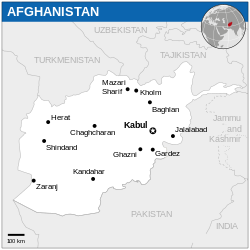Ravaged By Floods: Afghanistan’s Desperate Plight
No Comments yet
Map en.wikipedia.org
05-15-2024 ~ Unprecedented flash floods wreak havoc in Afghanistan, leaving devastation in their wake and plunging the nation into crisis.
Nearly 315 people have died, and over 1,600 have suffered injuries in catastrophic flash floods that swept through various provinces in Afghanistan on Friday, May 10. Authorities have declared a state of emergency in response to the situation. Northern Baghlan province bore the brunt of the devastation, with a death toll of over 300 and thousands of houses either destroyed or damaged. Torrential rains have wreaked havoc in several provinces, including Takhar, Badakhshan, Ghor, and Herat.
Flash floods happen when heavy rain overwhelms normal drainage. Climate change, which warms the atmosphere, boosts extreme rainfall, increasing the likelihood of these events. These floods have had a deep impact on the population, as many have lost homes and livelihoods. Rescue teams are working on the ground, but reaching flooded areas has become tough.
Meanwhile, the UN Secretary-General, Antonio Guterres, expressed his solidarity with the people of Afghanistan and extended his condolences to the families of the victims. He added that the UN was collaborating with local authorities to provide assistance.
Afghanistan ranks among the 10 most vulnerable countries to climate change and has been experiencing a rise in extreme weather conditions, particularly floods, droughts, and sand and dust storms. These phenomena have led to the loss of lives and livelihoods, as well as significant damage to infrastructure. Yet, despite being one of the countries most vulnerable to climate change, Afghanistan was not represented at COP27, the crucial 2022 UN Climate Change Conference in Sharm El-Sheikh, Egypt. Nations acknowledged the need for finance to tackle climate-related loss and damage, agreeing to establish a fund and funding arrangements.
Drought and Extreme Weather Conditions
In 2022, Afghanistan confronted its most severe drought in 30 years, worsening an already challenging scenario in a nation where drought ranks as the most frequently reported disaster among households. Rising temperatures are swiftly altering precipitation patterns, resulting in reduced water accessibility for the people. This scarcity not only impacts livelihoods but also escalates disease outbreaks and prompts displacement within communities. Over the years, the mean annual temperature has experienced a substantial increase, increasing glacier and snow melt, which serve as crucial water sources for rivers during the summer months. Between 1960 and 2008, the mean annual temperature climbed by 0.6 degrees Celsius, with an additional rise of 1.2 degrees Celsius from 2009 to 2016, amplifying the challenges confronting the country.
A substantial number of Afghanistan’s primary rivers originate in the central highlands, specifically in Bamyan and Daikundi Provinces. Nevertheless, these critical water sources are currently facing significant challenges due to unpredictable rainfall and rapid alterations in the quantity and timing of snowfall at elevated altitudes. Persistent drought conditions are leading to the depletion of surface-water sources such as springs, while also causing a decline in groundwater levels for hand-dug and shallow wells. In Kabul Province, various wells have dried up resulting in an acute water shortage.
Amid the severe droughts and rising temperatures, Afghanistan is experiencing significant fluctuations in extreme weather patterns. In August 2022, neighboring Pakistan received more than three times its typical rainfall, making it the wettest August since 1961. While not to the same degree, Afghanistan also encountered unusually intense heavy rains and flooding during the same month, predominantly impacting the central, eastern, western, and southeastern regions of the country.
This type of weather is making it harder for people to get enough food, leading to more malnutrition and sickness. It’s even worse because the economy is struggling, and the effects of 40 years of war have made things tough. Half of the population doesn’t have enough to eat, and 6 million people are very close to starving.
In Afghanistan, the prevalence of child stunting is alarmingly high, with 41 percent of children under the age of five affected. Additionally, the rate of wasting, which represents severe acute malnutrition, is also remarkably elevated at 9.5 percent. Anemia affects one in three adolescent girls in the country.
Since the Taliban’s takeover in 2021, the Afghan economy has contracted by 27 percent, leading to economic stagnation. Unemployment has doubled, and only 40 percent of the population has access to electricity. Sectors like finance have essentially collapsed, and there are no major sources of economic activity such as exports or public expenditure, leaving small and medium enterprises and farmers as the lifeblood of the faltering economy.
What Has Led to This?
One of the main reasons for Afghanistan’s crisis was the long-lasting war that damaged the country inside and out. To address climate change and the economic crisis, the country requires significant financial resources. However, strict measures from the U.S. and the Taliban’s policies have prevented this from happening. Similar to numerous nations impacted by global warming, Afghanistan has made minimal contributions to the issue and will require substantial international assistance to withstand its effects.
Before August 2021, Afghanistan relied heavily on foreign aid, accounting for 75 percent of its economy. When the Taliban took over on August 15, 2021, donor governments, led by the U.S., told the World Bank to stop providing around $2 billion in international aid. This aid had been used to pay salaries for millions of teachers, health workers, and other essential staff, as well as for various projects funded by organizations like the International Development Association. These funds helped many Afghan families, including those who were very poor, by providing cash-for-work opportunities, cash distributions, and support for their livelihoods.
However, when this aid was cut off, countless Afghan households lost their main source of income. Additionally, budgetary support from organizations like the International Monetary Fund (IMF), the U.S. Agency for International Development, and the Asian Development Bank (ADB) was also stopped. As a result, the Afghan Central Bank lost its ability to work with international banks and financial institutions like the World Bank, IMF, and ADB.
The bans on female education and Afghan women working in NGOs and the UN have severely harmed Afghanistan’s long-term economic and social progress. They have hastened the departure of educated women and men, leading to a brain drain. Moreover, these restrictions have dampened donors’ willingness to offer ongoing humanitarian aid. Additionally, the Taliban’s successful implementation of a ban on opium poppy cultivation has led to approximately $1 billion in lost annual income for rural Afghan households. Consequently, the nation is increasingly dependent on coal exports, leading to illegal mining in various areas and raising climate concerns.
This series of events in Afghanistan paints a dire picture of struggle and hardship. The devastating flash floods, coupled with the ongoing economic crisis and the long-lasting impacts of war, have left the country reeling.
By Pranjal Pandey
Author Bio: This article was produced by Globetrotter.
Pranjal Pandey, a journalist and editor located in Delhi, has edited seven books covering a range of issues available at LeftWord. You can explore his journalistic contributions on NewsClick.in.
Source: Globetrotter
You May Also Like
Comments
Leave a Reply







